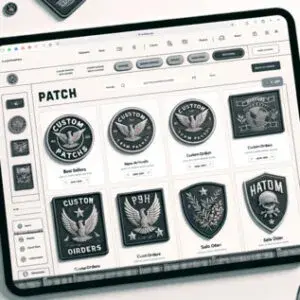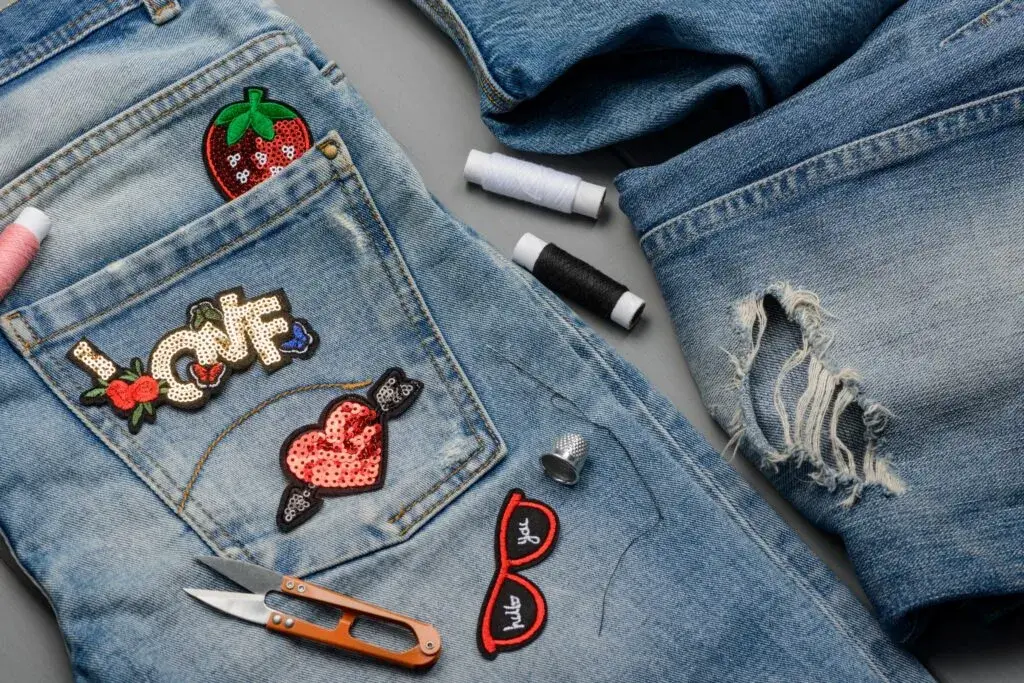How to Start A Custom Patches Business – A Beginner’s Guide
Want to start a custom patches business? You’re making an excellent choice. Custom patches are not only in demand, but they also don’t require a high initial investment. With a good business model and some creativity, your patch startup could really take off! Read on for a beginner’s guide on how to start your very own patch making company.
Why Start a Custom Patches business?
Businesses can be difficult to get going. You need to find a product that’s in demand, and be able to produce it at a reasonable cost. With custom patches, you already have the demand as there are countless organizations and individuals looking for unique custom patches for clothing or uniforms.
What’s more, the production process is not overly complex or expensive. As such, you can start small and scale up as your business grows. Here are a few more reasons why starting a custom patch business is a great idea:
- Low overhead costs. You can even outsource the production process to keep your overheads low. This means all you need to start making patches is a production partner and some creativity.
- Little storage space required. As patches are relatively small, you won’t need a large warehouse or storage space to keep your inventory. It also means lower costs.
- Popular products. Custom patches have a strong niche market and are highly sought after by both the alternative fashion crowd and organizations such as sports teams, schools, and scouting groups.
- Easy to customize. Some products like t-shirts or mugs have limited customization options. However, patches can be made in a wide range of designs, shapes, and sizes.
- High profit margins. Patches can sell for a high markup, especially when you start producing larger quantities. This means the potential for good profits is definitely there!

How to Start a Custom Patches Business
If you’ve decided to sell custom patches online, then read on – we’ve put together some tips on how to get started with your very own patch business.
1. Figure Out Your Niche
It’s always better to start narrow rather than broad. Many of the world’s most successful companies started with one minimum viable product before growing to be the powerhouses they are today. For your custom patch business, start by figuring out what niche you want to cater to.
Some ideas include:
- Custom embroidered patches for military and law enforcement personnel
- Unique iron-on patches for the punk, alternative and heavy metal fashion crowd
- Personalized patches for sports teams, schools, and scouting groups with specific designs and logos
Kickstart your designs with AI
Leverage the power of AI to streamline your design process,
turning your ideas into polished, production-ready products with ease.
If you have a specific niche, it’s easier to compete against larger, more established patch companies. Customers might stop and think twice before they order custom patches from the big players when they can get them from a company that caters to their specific niche interests or needs.
Once you start getting those sales, you can always expand your product line and cater to a broader customer base over time.
2. Decide on Your Business Model
We’re lucky that we live in a time where there are so many options for starting an online business. With custom patches, you have a few different models to choose from:
Print on Demand
You might have heard of other small online merchants using Print on Demand (POD) as their business model. It’s a process where products are produced and shipped by a third-party company only after a customer places an order.
It’s a popular model for a few reasons – it requires lower upfront costs and now inventory space. However, when it comes to custom patches, POD is not a viable option. POD services are designed for more generic and easily replicable items, which doesn’t work for custom patches.
Dropshipping
Similar to POD, dropshipping involves working with a third-party company to fulfill your patch orders. However, in this model, you use pre-made designs that are already in stock with the manufacturer, and they handle the shipping directly to your customers.
This model is best for those who don’t have any design skills or don’t want to deal with the production and fulfillment process. However, you may face competition from other sellers using the same pre-made designs.
In-House Production
In-house production means you take on the responsibility of creating and fulfilling your own patch orders. You will need to invest in equipment, materials, and space for inventory. However, this model allows for complete customizability and control over the production process.
If you have the resources and skills to create high quality patches, this may be a more profitable option in the long run. But it’s undeniably a lot of work. You’re essentially setting up your own mini factory.
Custom Manufacturing
Custom manufacturing involves working directly with a patch manufacturer to create your orders. This method is similar to in-house production, but you don’t need to invest in equipment.
You can collaborate with a patch making company to create completely unique designs and have more control over the quality of the patches. They’ll ship the patches to your business and you have the responsibility of fulfillment.
This option is a great choice for those who want a high-degree of control over the creative process but don’t have the equipment or resources for in-house production.

3. Create a Business Plan
The best way to start a patch startup is with a solid business plan. This plan will serve as your roadmap and help you stay on track. As with any new business, it’s easy to get lost in the details. You might be several months in and realize that you’re spending more money on supplies than what you’re making back in sales.
Here are some things you should ask yourself when creating a business plan for your patch making company:
- What are my business goals?
- Who is my target audience?
- How much money do I have to invest in this venture?
- How much will I charge for my custom patches?
Having clear answers to these questions will help you define your business and create a plan that’s both useful and realistic. It might also throw up a few challenges that you wouldn’t have otherwise thought of.
4. Start Designing Your Custom Patches
Once you’ve got your business plan sorted, it’s time to get creative. If designing isn’t your strong suit, you can always hire a graphic designer or collaborate with one to get your ideas onto paper.
You’ll need to consider factors such as size, shape, colors, and materials. You should also think about the purpose of your patches. Are they for branding, identification, or promotion?
Remember to keep your target audience in mind when designing. What will appeal to them? Will your design stand out amongst other patches in the market?
Different patch types require certain considerations when designing. For example, printed patches can be quite detailed while embroidered patches may be limited by the size of the stitching. It’s a good idea to research and test different patch types before creating your final design.

5. Choose What Type of Patches You Want To Create
Following on from what we just said, it’s important to decide what type of patches you want to create! Some popular options include:
- Woven Patches. These patches are made using colored threads that are woven together, resulting in a smooth and detailed design.
- PVC Patches. Made from soft rubber, these patches add a 3D effect to designs and can be used for outdoor purposes.
- Embroidered Patches. These patches add a textured and raised effect to designs, making them popular for branding and uniforms.
- Leather Patches. Ideal for a more high-end look, these patches are created by printing onto leather or vegan leather before being placed onto the patch backing.
- Printed Patches. If you want a photo-realistic or highly detailed design, these are regarded as the best custom patches.
- Bullion Patches. These patches look more elegant than your typical patches, using gold and silver threads to create the design.
- Chenille Patches. Think of letterman jackets or sports teams. These patches are fuzzy and textured and are generally associated with sports teams.
6. Build Your Brand
Starting a custom patch business means you need to give your company an identity! You’re probably already thinking about brand names, but there’s more to building a brand than just the name. Consider other elements like:
- Logo Design. Your logo is often the first thing people will see when they come across your business. Make it stand out and be memorable.
- Brand Colors. Choosing specific colors for your brand can help create a cohesive look for all of your patches, packaging, and marketing materials.
- Brand Voice and Tone. How you communicate with your customers is an important aspect of building your brand. Will you have a more casual and friendly tone or a more professional and formal one?
- Brand Story. Share the story behind your patch business. What inspired you to start it, what values do you hold, and how do these reflect in your products?
If graphic design isn’t your thing, you can always hire a freelancer for things like logo design. Websites like Fiverr.com and Upwork.com are great resources for finding affordable design services.
7. Set Up Your Online Presence
You need to think about where you will be selling your patches. While traditional brick-and-mortar stores are an option for some, most people sell their patches online nowadays. This way, you can reach a wider audience and lower your overhead costs. Here are a few things to consider when setting up your online presence:
- E-commerce Platform. There are a variety of e-commerce platforms available such as Shopify, WooCommerce, and BigCommerce. These platforms make it easy to set up an online store without extensive technical knowledge.
- Website Design. Your website is the face of your business, so invest time in creating a beautiful website. Again, if design isn’t your forte, you may want to hire a freelancer.
- SEO (Search Engine Optimization). SEO is the process of optimizing your website and content to rank higher in search engine results. It’s incredibly important – if no one can find your website, how will you make sales? Take some time to learn the basics of SEO or hire an expert to help you.
- Product Photography. You need high quality photos of your high quality patches! You might want to invest in a good camera or if it’s within reach, hire a professional photographer for this task.
- Social Media Storefronts. Many social media platforms such as TikTok and Instagram have built-in shopping features that allow you to sell directly from your account. This can be a great way to reach a really wide audience and introduce them to your brand.

8. Market Your Patch Company
Once you have your online store set up, it’s time to start marketing your business. This usually means paying for advertisements, but there are also some free and creative ways to get the word out about your patch startup:
- Influencer Collaborations. Reach out to influencers in your niche and offer them free patches or a discount code in exchange for promoting your products. This can expose your brand to their followers and potentially bring in new customers.
- Collaborations with Other Brands. Partner with other businesses that have a similar target audience and offer a special bundle deal or cross-promote each other’s products. This can help expand your reach and introduce your brand to new customers.
- Local Events. Attend local events and craft fairs to showcase your patches and connect with potential customers in person. This is a great opportunity to get feedback on your products and make personal connections with your target audience.
- Word of Mouth. Don’t underestimate the power of word-of-mouth marketing. Encourage satisfied customers to share their experience with friends and family, and consider offering a referral program for those who bring in new customers.
- Paid Advertising. The majority of online stores rely on paid advertising to get off the ground. Targeted ads on platforms like Google and Instagram can help reach potential customers and drive traffic to your website. But be sure to set a budget and track the effectiveness of your ads.
- Create a Strong Social Media Presence. Small businesses and startups have often hit gold with a strong social media presence. Quirky, creative, and engaging media content can quickly help you gain traction and spread the word about your brand.
9. Scale and Grow Your Patch Startup
Starting a custom patch business requires patience, creativity, and persistence. But once you’ve done the groundwork, you can start growing, scaling, and earning a sustainable income. Here are some tips to help you take your patch business to the next level:
- Expand Your Product Line. While custom patches may be your main product, consider expanding your offerings to include other accessories such as pins, stickers, or keychains that complement your brand and add value for customers. Don’t be afraid to experiment with new products!
- Keep Updating Your Designs. Make sure you regularly add fresh designs to your collection. This will keep customers interested and coming back for more, as well as potentially attract new customers.
- Collaborate with Other Businesses. Partnering with other small businesses or influencers can help expand your customer base and bring in new followers. You could collaborate on a limited edition patch design or host a joint giveaway to attract more attention.

Ready to Set Up Your Own Patch Patch Business?
If you feel inspired and ready to start your own custom patch company, then we’re here to help you get off the ground! At THE/STUDIO, we can help you make patches for your business, with no minimum order quantity and unlimited customization. Our easy-to-use online patch maker and dedicated customer support team make it easy for you to turn your patch business dreams into reality. So if you’re ready to get started, head over to our website and start creating your custom patches today!
FAQs
What do I need to make custom patches?
If you’re making patches yourself, you will need embroidery machines, digitizing software, and materials such as fabric and thread. If you’re working with a manufacturer like THE/STUDIO, all you need is your design and our team will take care of the rest!
Is there a market for patches?
Absolutely! Custom patches have become increasingly popular in recent years, especially in the alternative fashion scene. The demand for unique and personalized items has grown, making custom patches a hot commodity. Some companies have built their entire business model on custom patches and they’re still thriving.
What is the best fabric for custom patches?
I t depends on the type of patch and what it will be used for. Some commonly used fabrics for patches include twill, canvas, felt, and denim. Some patches can even be made with PVC or leather, which can suit different styles and purposes.
How long does it take to make a patch?
At THE/STUDIO, we offer a variety of production times to fit your needs and budget. Our standard production time is 2-3 weeks, but we also offer rush options for those who need their patches sooner.




